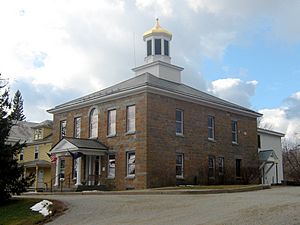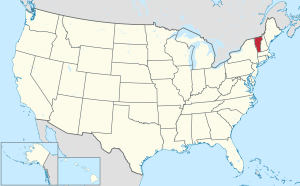Grand Isle County, Vermont facts for kids
Quick facts for kids
Grand Isle County
|
|
|---|---|

Grand Isle County Courthouse in North Hero
|
|

Location within the U.S. state of Vermont
|
|
 Vermont's location within the U.S. |
|
| Country | |
| State | |
| Founded | 1805 |
| Shire Town | North Hero |
| Largest town | Alburgh (town) |
| Area | |
| • Total | 195 sq mi (510 km2) |
| • Land | 82 sq mi (210 km2) |
| • Water | 113 sq mi (290 km2) 58% |
| Population
(2020)
|
|
| • Total | 7,293 |
| • Density | 37.40/sq mi (14.44/km2) |
| Time zone | UTC−5 (Eastern) |
| • Summer (DST) | UTC−4 (EDT) |
| Congressional district | At-large |
Grand Isle County is a county in the U.S. state of Vermont. As of the 2020 census, the population was 7,293, making it Vermont's second-least populous county. Its shire town (county seat) is North Hero. The county was created in 1802 and organized in 1805.
Grand Isle County is part of the Burlington metropolitan area. The county does not have a high school; students choose from a number of high schools in neighboring counties.. The county consists of several discontiguous and sparsely populated islands and peninsulas of Lake Champlain, connected to each other by U.S. Route 2.
Contents
History
Grand Isle County is one of several Vermont counties created from land ceded by the state of New York on January 15, 1777, when Vermont declared itself to be a distinct state from New York. The land was originally contested by Massachusetts, New Hampshire, New France and New Netherland, but it remained undelineated until July 20, 1764, when King George III established the boundary between New Hampshire and New York along the west bank of the Connecticut River, north of Massachusetts and south of the parallel of 45 degrees north latitude. New York assigned the land gained to Albany County. On March 12, 1772, Albany County was partitioned to create Charlotte County, and this situation persisted until Vermont's independence from New York and Britain, which, however, did not end the contest.
On September 3, 1783, as a result of the signing of the Treaty of Paris, the Revolutionary War ended with Great Britain recognizing the independence of the United States. Vermont's border with Quebec was established at 45 degrees north latitude, which explains why this county has no dry-land connection to the rest of the United States.
Massachusetts did not formally withdraw its claim to the region, first made in 1629, until December 16, 1786. New York, still not satisfied with the relinquishment of its land to Vermont, asked the U.S. Congress to arbitrate the matter. Congress ruled against New York on March 7, 1788.
Subsequently, when Vermont petitioned for statehood, Congress ordered a joint commission to settle the border between New York and Vermont. This commission ruled before Vermont's admission, which took place on March 4, 1791, but a small change they permitted has never been acted upon. Grand Isle County was created in 1802 from parts of Franklin and Chittenden Counties.
In the late 19th century the Rutland Railroad ran service from northern New York State by the Canada–U.S. border, along the west side of Vermont to Rutland, Vermont, and south to Chatham, New York. From 1899 a series of causeways provided continuous train service north–south through the Lake Champlain islands, making a direct connection to Burlington. The last service from Alburgh was in 1948.
Geography
According to the U.S. Census Bureau, the county has a total area of 195 square miles (510 km2), of which 82 square miles (210 km2) is land and 113 square miles (290 km2) (58%) is water. It has the highest proportion of water coverage of any county in the state. It is the smallest county in Vermont by area, and the second-smallest by population (only Essex County has fewer people). Four of its five towns (North Hero, South Hero, Grand Isle and Isle La Motte) are situated entirely on islands in Lake Champlain, while Alburgh is on a peninsula (an exclave known as the Alburgh Tongue) extending south into the lake from Quebec. The highest elevation in the county is only 279 feet, on the west side of South Hero. The lake shoreline elevation is generally 99' above sea level.
There are three main inhabited islands, one inhabited peninsula, and many smaller uninhabited islands in Grand Isle County. Alburgh is the physically largest landmass of Grand Isle County, and it lies on a peninsula that borders Quebec to the north. Isle La Motte, North Hero Island, and Grand Island are the three inhabited islands. Grand Isle County does not share any land borders with the Contiguous United States, however there are three roadway bridges that connect Grand Isle County with the mainland United States with two bridges connecting to Vermont and one to New York State at Rouses Point, New York.
Adjacent counties
- Franklin County – east
- Chittenden County – southeast
- Clinton County, New York – west
- Le Haut-Richelieu Regional County Municipality, Quebec – north
Major highways
 US 2
US 2 VT 78
VT 78
 VT 129
VT 129 VT 225
VT 225
Demographics
| Historical population | |||
|---|---|---|---|
| Census | Pop. | %± | |
| 1810 | 3,445 | — | |
| 1820 | 3,527 | 2.4% | |
| 1830 | 3,696 | 4.8% | |
| 1840 | 3,883 | 5.1% | |
| 1850 | 4,145 | 6.7% | |
| 1860 | 4,276 | 3.2% | |
| 1870 | 4,082 | −4.5% | |
| 1880 | 4,124 | 1.0% | |
| 1890 | 3,843 | −6.8% | |
| 1900 | 4,462 | 16.1% | |
| 1910 | 3,761 | −15.7% | |
| 1920 | 3,784 | 0.6% | |
| 1930 | 3,944 | 4.2% | |
| 1940 | 3,802 | −3.6% | |
| 1950 | 3,406 | −10.4% | |
| 1960 | 2,927 | −14.1% | |
| 1970 | 3,574 | 22.1% | |
| 1980 | 4,613 | 29.1% | |
| 1990 | 5,318 | 15.3% | |
| 2000 | 6,901 | 29.8% | |
| 2010 | 6,970 | 1.0% | |
| 2020 | 7,293 | 4.6% | |
| U.S. Decennial Census 1790–1960 1900–1990 1990–2000 2010–2018 |
|||
2010 census
As of the 2010 United States Census, there were 6,970 people, 2,902 households, and 2,027 families living in the county. The population density was 85.2 inhabitants per square mile (32.9/km2). There were 5,048 housing units at an average density of 61.7 units per square mile (23.8 units/km2). The racial makeup of the county was 95.3% white, 0.9% American Indian, 0.4% black or African American, 0.3% Asian, 0.1% Pacific islander, 0.3% from other races, and 2.8% from two or more races. Those of Hispanic or Latino origin made up 1.1% of the population. In terms of ancestry, 18.0% were English, 14.2% were Irish, 10.6% were French Canadian, 10.3% were German, 10.3% were American, and 6.9% were Scottish.
Of the 2,902 households, 28.4% had children under the age of 18 living with them, 56.2% were married couples living together, 8.6% had a female householder with no husband present, 30.2% were non-families, and 22.5% of all households were made up of individuals. The average household size was 2.40 and the average family size was 2.79. The median age was 45.5 years.
The median income for a household in the county was $57,436 and the median income for a family was $66,686. Males had a median income of $46,569 versus $36,514 for females. The per capita income for the county was $30,499. About 6.1% of families and 6.4% of the population were below the poverty line, including 9.9% of those under age 18 and 3.7% of those age 65 or over.
Communities
Towns
- Alburgh
- Grand Isle
- Isle La Motte
- North Hero (shire town)
- South Hero
Village
Census-designated place
- South Hero
Notable person
- Bernie Sanders, former mayor of Burlington (1981–1989), U.S. Senator from Vermont since 2007, and 2016 and 2020 Democratic presidential candidate
See also
 In Spanish: Condado de Grand Isle para niños
In Spanish: Condado de Grand Isle para niños

